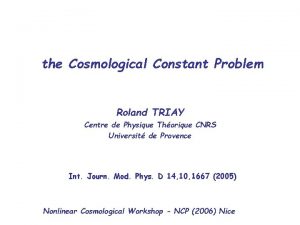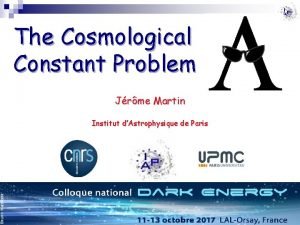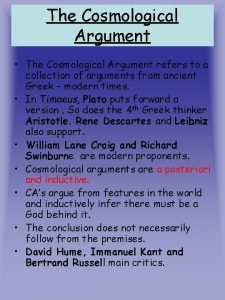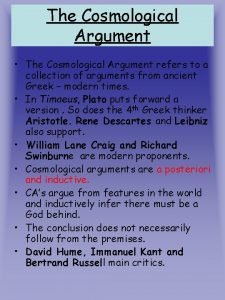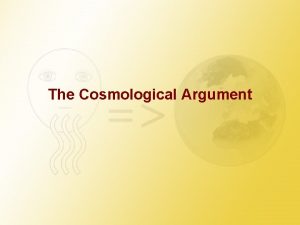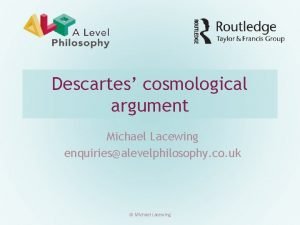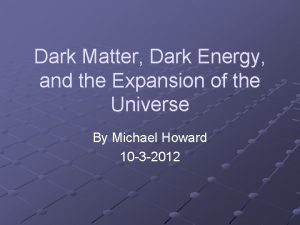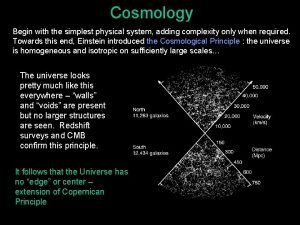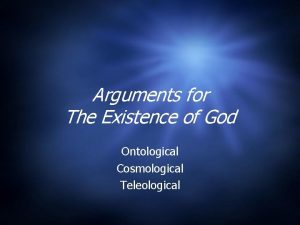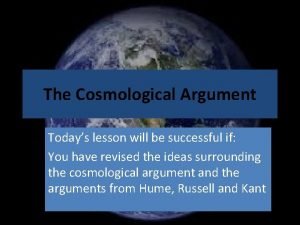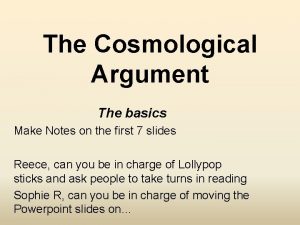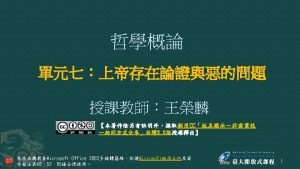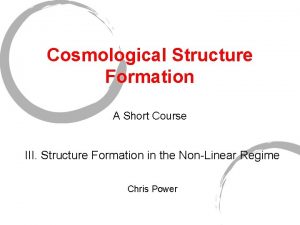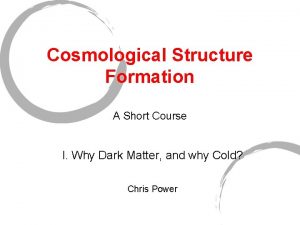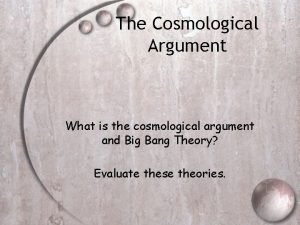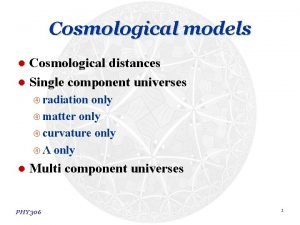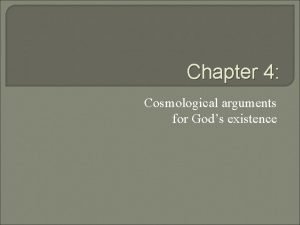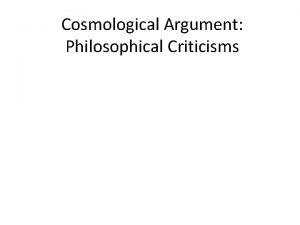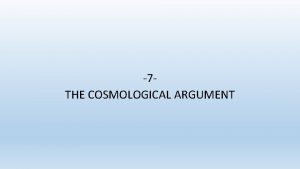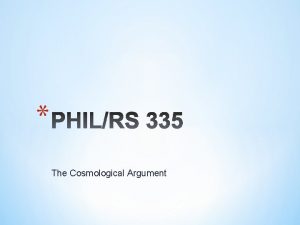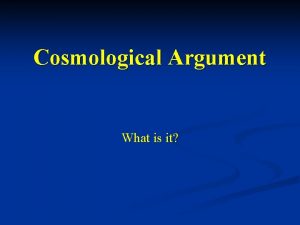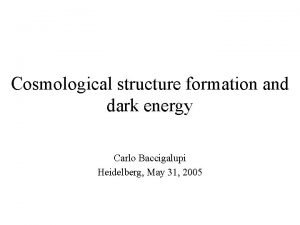Cosmological Structure Formation A Short Course II The

















- Slides: 17

Cosmological Structure Formation A Short Course II. The Growth of Cosmic Structure Chris Power

Recap • The Cold Dark Matter model is the standard paradigm for cosmological structure formation. • Structure grows in a hierarchical manner -- from the “bottom-up” -- from small density perturbations via gravitational instability • Cold Dark Matter particles assumed to be nonthermal relics of the Big Bang

Key Questions • Where do the initial density perturbations come from? • Quantum fluctuations imprinted prior to cosmological inflation. • What is the observational evidence for this? • Angular scales greater than ~1° in the Cosmic Microwave Background radiation. • How do these density perturbations grow in to the structures we observe in the present-day Universe? • Gravitational instability in the linear- and non-linear regimes.

Cosmological Inflation • Occurs very early in the history of the Universe -- a period of exponential expansion, during which expansion rate was accelerating or alternatively, during which comoving Hubble length is a decreasing function of time

Cosmological Inflation • Prior to inflation, thought that the Universe was in a “chaotic” state -- inflation wipes out this initial state. • Small scale quantum fluctuations in the vacuum “stretched out” by exponential expansion -- form the seeds of the primordial density perturbations. • Can quantify the “amount” of inflation in terms of the number of e -foldings it leads to

Cosmological Inflation • Turns out the ~70 e-foldings are required to solve the so-called classical cosmological problems • • Flatness Horizon Abundance of relics -- such as magnetic monopoles Homogeneity and Isotropy • Inflation thought to be driven by a scalar field, the inflaton -- could it also be responsible for the accelerated expansion (i. e. dark energy) we see today? • Turns out that angular scales larger than ~1º in the CMB are relevant for testing inflation -- also expect perturbations to be Gaussian.

The Seeds of Structure Temperature Fluctuations in the Cosmic Microwave Background Credit: NASA/WMAP Science Team (http: //map. gsfc. nasa. gov)

Temperature and Density Pertubations • • CMB corresponds to the last scattering surface of the radiation -- prior to recombination Universe was a hot plasma -- at z~1400, atoms could recombine. Temperature variations correspond to density perturbations present at this time -- the Sachs-Wolfe effect:

Characterising Density Perturbations • We define the density at location x at time t by • This can be expressed in terms of its Fourier components • Inflation predicts that can be characterised as a Gaussian random field.

Gaussian Random Fields • The properties of a Gaussian Random Field can be completely specified by the correlation function • Common to use its Fourier transform, the Power Spectrum • Expressible as

Aside : Setting up Cosmlogical Simulations • Generate a power spectrum -- this fixes the dark matter model. • Generate a Gaussian Random density field using power spectrum. • Impose density field d(x, y, z) on particle distribution -- i. e. assignment displacements and velocities to particles.

Linear Perturbation Theory • Assume a smooth background -- how do small perturbations to this background evolve in time? • Can write down • the continuity equation • the Euler equation • Poisson’s equation

Linear Perturbation Theory • Find that • the continuity equation leads to • the Euler equation leads to • Poisson’s equation leads to

Linear Perturbation Theory • Combine these equations to obtain the growth equation • Can take Fourier transform to investigate how different modes grow

Linear Perturbation Theory • Linear theory valid provided the size of perturbations is small - <<1 • When ~1, can no longer trust linear theory predictions -problem becomes non-linear and we enter the “non-linear” regime • Possible to deduce the approximate behaviour of perturbations in this regime by using a simple model for the evolution of perturbations -- the spherical collapse model • However, require cosmological simulations to fully treat gravitational instability.

Next Lecture • The Spherical Collapse Model • Defining a dark matter halo • The Structure of Dark Matter Haloes • The mass density profile -- the Navarro, Frenk & White “universal” profile • The Formation of the First Stars • First Light and Cosmological Reionisation

Some Useful Reading • General • “Cosmology : The Origin and Structure of the Universe” by Coles and Lucchin • “Physical Cosmology” by John Peacock • Cosmological Inflation • “Cosmological Inflation and Large Scale Structure” by Liddle and Lyth • Linear Perturbation Theory • “Large Scale Structure of the Universe” by Peebles
 Long and short
Long and short Roland triay
Roland triay Cosmological constant
Cosmological constant St thomas aquinas cosmological argument
St thomas aquinas cosmological argument St thomas aquinas cosmological argument
St thomas aquinas cosmological argument St thomas aquinas cosmological argument
St thomas aquinas cosmological argument Descartes cosmological argument
Descartes cosmological argument Einstein cosmological constant
Einstein cosmological constant Lookback time
Lookback time Ontological cosmological teleological
Ontological cosmological teleological Kant's criticism of cosmological argument
Kant's criticism of cosmological argument Cosmological argument poster
Cosmological argument poster Argument from contingency
Argument from contingency Formation initiale vs formation continue
Formation initiale vs formation continue T junction flemish bond
T junction flemish bond Course title and course number
Course title and course number Course interne course externe
Course interne course externe Neuhof sign dvt
Neuhof sign dvt

